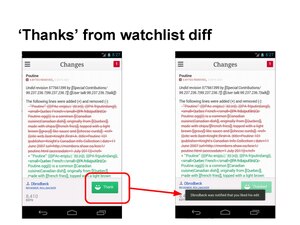Wikimedia Engineering/Report/2013/October/summary
| Summary of the Wikimedia engineering October 2013 report | Summary for November 2013 |
- This content is prepared for inclusion in the October 2013 Wikimedia Foundation report. It is a shorter and simpler version of the full Wikimedia engineering report for October 2013 that does not assume specialized technical knowledge.
Major news in October include:
- A report on the Open Access Media Importer, a tool that transfers multimedia files from scientific publications to Wikimedia Commons;
- A request for proposals for a new datacenter in the continental US, published by the Operations team;
- The creation of the Autonym Font, which allows language names to be displayed properly without degrading page loading time.
In October, the VisualEditor team continued to improve the stability and performance of the system, and add new features. The version of the software present on Wikimedia sites was updated five times. Beyond fixing bugs, the focus of the team's work this month was to make the system more reliable and easier to extend.
They also continued to improve usability. For example, you now need to press the "delete" key twice to delete a template, reference or image; the first time, they only become selected, to avoid accidental deletion of infoboxes and similar content. A new feature, allowing users to switch from editing in VisualEditor to editing wikitext directly without having to save the page, was also added.
In October, the Parsoid team continued to work on the conversion between wikitext and annotated HTML for unusual cases. Speed was improved by making the software run more requests at the same time. The speed of the testing server used to check for conversion errors was also improved: we can now run tests on 160,000 pages overnight. Support for private wikis was also added this month.
In October, we enabled Notifications worldwide on about 800 Wikimedia sites, including most of the remaining Wikipedia wikis and 'sister projects'. Community members we've spoken to generally find this tool helpful, across languages and world regions. Notifications are also available on mobile devices, and seem to be adding value on these platforms as well. We now plan a final release of Notifications on the German and Italian editions of Wikipedia at the end of November.
In October, the Flow team redesigned the prototype of this new discussion system. We also continued to add basic features. We held a User Experience workshop, primarily with users new to Wikipedia, to get feedback on the usability of the new design. We're planning to demo the basic Flow product to interested WikiProjects in November to get more feedback on what's needed for a first trial on Wikipedia.
In October, the Growth team completed its sixth and final major A/B test of the GettingStarted and GuidedTour extensions for the onboarding new Wikipedians project. Data analysis results for this test were also published, making way for rolling out the winning version on non-English Wikipedias in November. This month, the team also completed background research and early designs for its upcoming work on anonymous editor acquisition and Wikipedia article creation.

Many changes were made to the iOS Commons app in October. Users can now select the license among the most common ones, and swipe to delete categories on yet-to-be-uploaded images. A number of visual and interface improvements have been made, notably for iOS 7 compatibility. Icon consistency has been improved throughout the app. The app now also has better internationalization support, as well as better landscape and iPad support.
The Wikipedia Zero team, supporting the program to give Wikipedia access to mobile users at no cost, worked on many features and enhancements as well. Part of their work focused on reducing accidental data charges, for example by adding warnings for users who don't benefit from the Zero program. They also made improvements to the settings system that allows the configuration of parameters for different mobile companies.
The mobile web team has been focusing on many new features, as well as running tests about new mobile editors. They've improved the general design for a better user experience, and started to try to integrate VisualEditor to tablets. In beta, user profiles are now available, as well as 'Keep Going', a series of calls to action for new editors.
